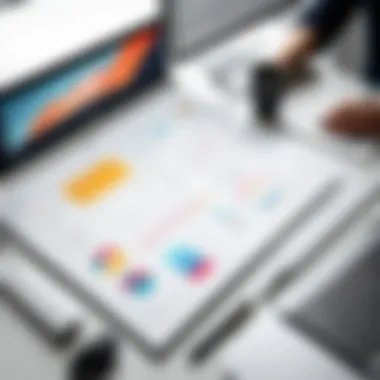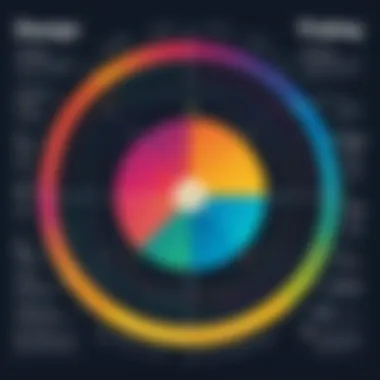Exploring Design Thinking: IDEO's Innovative Approach


Intro
Design thinking is more than just a buzzword in the world of innovation; it is a transformative methodology that has reshaped how products and services are conceived and developed. Pioneered by IDEO, design thinking emphasizes a human-centered approach to problem-solving. This exploration delves into the core principles and processes that underpin design thinking, its applications across various industries, and its impact on fostering innovation.
By examining real-world case studies, we can see how this methodology enhances both creativity and functionality. The following sections will dissect various facets of design thinking, offering insights into its challenges and future directions. The aim is to present a comprehensive guide that highlights the significance of IDEO's approach in crafting effective design strategies and solutions.
Intro to Design Thinking
The concept of design thinking is crucial in understanding how innovative solutions come into being. This article delves into the intricacies of this powerful methodology, specifically as it has been shaped and popularized by IDEO. By introducing design thinking, we set the stage for comprehending its fundamental principles and processes that guide designers and organizations in solving complex problems.
Design thinking emphasizes a human-centered approach and fosters collaboration, creativity, and experimentation. As the landscape of industries evolves, so does the need for effective problem-solving techniques. Design thinking addresses this need by offering tools and perspectives to navigate ambiguity, ensuring solutions are not just functional, but also resonate with users.
Definition of Design Thinking
Design thinking can be defined as a methodology that employs the use of a user-centric approach in problem-solving. It integrates techniques from various disciplines, enabling individuals to discover innovative solutions that are closely aligned with user needs. The core idea is to observe and understand the user's experience, insights that can ultimately guide the development of better products or services.
At its heart, design thinking involves iterative processes—repeating steps such as empathizing, defining, ideating, prototyping, and testing. Each stage builds upon the insights gathered from prior steps, leading to refined solutions. This iterative nature ensures adaptability, allowing teams to pivot based on feedback and challenges encountered along the way.
Historical Context
The origins of design thinking can be traced back to the early 20th century, but it gained significant traction in the late 20th century through the work of IDEO. Founded in 1991, IDEO aimed to bridge the gap between technological feasibility, human desirability, and business viability. This synthesis laid the groundwork for what we now recognize as design thinking.
Throughout the years, various influential figures have contributed to the evolution of design thinking. Notably, Herbert Simon, a pioneer in artificial intelligence and cognitive science, published "The Science of Design" in 1969, which set the foundation for design methodologies. Subsequent practitioners expanded on these ideas, ultimately leading to IDEO's formalization of the process, embedding it in the corporate world.
Design thinking's growth can be attributed to its ability to address complex challenges across multiple sectors. As businesses recognize the value of a human-centered approach, design thinking emerges as a vital tool, breaking down silos and fostering innovation. The blend of empathy and creativity provides a framework that resonates in today’s fast-paced, technology-driven environment.
IDEO's Role in Design Thinking
IDEO has played a pivotal role in popularizing and shaping the methodology of design thinking. The firm's innovative approach emphasizes a human-centered outlook, which is essential for creating products and services that genuinely resonate with users. IDEO's influence extends beyond design; it has permeated into business strategy, encouraging companies to embrace a more creative approach to problem-solving. This section delves into the founding and philosophy of IDEO, providing a deeper understanding of its core values and their significance in the design thinking framework.
Founding and Philosophy
IDEO was founded in 1991, emerging from the merger of three firms. The co-founder, David Kelley, envisioned an organization that fostered innovation through collaborative design processes. This founding principle highlights a distinctly multidisciplinary approach. IDEO's early success can be attributed to its unique ability to integrate various fields, from industrial design to behavioral science. IDEO believes that the best solutions come from diverse perspectives, which helps to address complex problems more effectively.
The company's philosophy is strongly rooted in understanding the user's needs. It encourages designers to immerse themselves in the user experience, promoting empathy as an essential skill. This approach not only leads to innovative products but also ensures that designs are practical and aligned with user expectations. IDEO’s philosophy underscores the crucial link between design and human experience, reinforcing the idea that successful design stems from understanding the deeper motivations and challenges faced by users.
Core Values of IDEO
The core values of IDEO are fundamental to its identity and approach to design thinking. These values serve as guiding principles for all projects undertaken by the firm:
- Empathy: This foundational value emphasizes the importance of putting oneself in the user's shoes. IDEO designers conduct interviews and observations to understand user pain points.
- Collaboration: IDEO fosters teamwork among individuals from various disciplines. This collaboration leads to richer ideas and more innovative solutions.
- Iterative Testing: The belief in trial and error is strong. IDEO promotes rapid prototyping, allowing designs to be tested and refined in response to feedback.
- Innovation: An ingrained culture of creativity encourages constant exploration of new ideas and approaches, which contributes to groundbreaking results.
Understanding these values is key for practitioners of design thinking. IDEO effectively demonstrates that by prioritizing empathy and collaboration, designers can create solutions that are not only innovative but also deeply connected to the users they serve.
"Design is not just what it looks like and feels like. Design is how it works." – Steve Jobs
As an influential conceptual framework, IDEO's contributions to design thinking have transformed how businesses address problems and pursue creativity. By integrating their core values into the design process, IDEO highlights the importance of user-centric solutions in today’s marketplace. This focus on empathy, collaboration, and continuous improvement shapes the future of design thinking and its implementation in various industries.
Key Stages of the Design Thinking Process


Design thinking is a methodical approach to problem-solving that emphasizes understanding users and their needs at every stage of the creative process. It provides a structured framework that guides teams through the journey of innovation. Each stage in the design thinking process is crucial, as it builds upon the previous one, fostering a deeper awareness of the problem and potential solutions. The five key stages of the design thinking process are Empathize, Define, Ideate, Prototype, and Test. Together, they form an iterative cycle that allows for refining ideas and developing effective solutions.
Empathize
The first step, Empathize, is fundamental in gathering insights about users. It involves engaging with people to understand their experiences, motivations, and challenges. This stage often employs methods such as interviews, observations, and immersion in the users' environment. By cultivating a sense of empathy, designers can gain a clearer perspective on what users truly need. This phase is not merely about collecting data; it’s about listening to real stories and understanding emotional contexts. The information gathered helps to humanize the problem at hand.
Define
After gathering insights, the next step is Define. This stage focuses on synthesizing the information collected during the empathizing phase to articulate a clear problem statement. It distills complex user data into a concise definition of the challenge. A well-crafted problem statement directs the design team’s focus towards a specific goal. It ensures that all efforts align with the users' needs, setting the foundation for the ideation phase. This clarity is vital for an effective design process.
Ideate
Once a clear problem is identified, the Ideate phase can commence. This is the brainstorming stage where creativity is paramount. The goal here is to generate a broad range of ideas and solutions without restraint. Techniques like brainstorming sessions, sketching, and mind mapping are often used. All ideas, no matter how unconventional, are welcomed in this phase. The key is to encourage divergent thinking, which can lead to innovative possibilities. Later, these ideas will be refined and narrowed down, but initially, the focus should be on quantity over quality.
Prototype
The Prototype stage transforms ideas into tangible forms. Prototyping is about experimenting and learning. This can include creating physical models, simulations, or wireframes of digital products. The purpose of prototypes is to visualize concepts and share them with others. They are not finished products but early representations that allow for feedback and exploration. This phase enables rapid testing, iteration, and adjustment, making it a critical component of the design process. Effective prototyping helps identify flaws early and facilitates refinement.
Test
Lastly, the Test phase involves evaluating the prototypes and gathering feedback from users. This stage is about learning how well the proposed solutions meet user needs. It often involves conducting usability tests and interviews to understand users' reactions and experiences with the prototypes. The insights gained during this phase can lead to further iterations and improvements. This cycle of testing and feedback fosters continuous learning and adaptation, which is a hallmark of design thinking.
"Design is not just what it looks like and feels like. Design is how it works." — Steve Jobs
Design Thinking in Practice
Design thinking in practice illustrates how the methodologies developed by IDEO can be employed across different scenarios and industries to address real-world issues. This section covers the significance of applying design thinking, highlighting its ability to foster innovation and enhance problem-solving capabilities.
By observing how design thinking operates in various forms, professionals can learn to adopt and adapt the principles to suit their unique contexts. Design thinking emphasizes a human-centered approach, making it paramount in creating solutions that resonate with users and meet their needs.
Case Studies
Product Development Example
One prominent case study in product development is the creation of the Palm V, a stylish personal digital assistant (PDA). The key aspect of this example is its user-centric design, which focused on the sleek aesthetics coupled with functionality. The Palm V became an exemplary choice in the tech industry due to its lightweight aluminum body and a distinctive design that set it apart from competitors.
The unique feature of the Palm V was its emphasis on both form and function. This focus resulted in a product that was not only technologically advanced but also visually appealing.
However, there were disadvantages to this approach. The premium materials increased production costs, making the Palm V more expensive than alternatives, which could deter some users.
Service Design Example
In terms of service design, the creation of the IDEO shopping cart is noteworthy. This case stresses how observation and empathy can lead to significant improvements in user experience. The main characteristic of the IDEO shopping cart redesign was its emphasis on understanding the shopper's journey.
It incorporated features like safety for children, ease of use for parents, and functionality for all users. This service prototype illustrates the benefits of a holistic design approach.
The unique feature of this case lies in its capacity to integrate feedback at various stages. However, the challenges included balancing competing interests of various stakeholders in development, which can complicate decision-making.
Social Innovation Example


A remarkable instance of design thinking in social innovation is the Solar Bottle Bulb project. This initiative aimed to provide sustainable lighting to underprivileged communities using readily available materials. The notable aspect of the project is its ability to address pressing societal issues through innovative design.
The key characteristic is the use of simple materials, such as plastic bottles, to create functional light sources. This serves not only to illuminate homes but also to promote environmental sustainability.
The unique feature is its low-cost model, making it accessible to those in need. However, scaling such solutions can be difficult due to geographical and resource constraints.
Application Across Industries
Technology
Design thinking in technology often leads to enhanced user experience, focusing on how products can be intuitive and accessible. One significant aspect is its iterative process, allowing developers to refine their products continuously based on user feedback. This adaptability in design is crucial for success in the ever-evolving tech landscape.
An example of this is Apple's design philosophy, which emphasizes aesthetics, simplicity, and user-centricity. The unique feature here is how design thinking enables rapid prototyping, allowing tech companies to test and implement new ideas quickly.
However, a challenge can arise with aligning diverse teams towards a unified vision, which might lead to conflict.
Healthcare
In the healthcare sector, design thinking has immense potential to improve patient care. The main contribution is the emphasis on empathy, which allows designers to create solutions that cater to the needs and experiences of patients.
For instance, the Philips Healthcare redesign of hospital equipment shows how understanding patient experience can lead to more effective solutions. The unique aspect is how design thinking fosters collaboration among healthcare professionals to address multifactorial challenges efficiently.
Nevertheless, implementing design thinking can face resistance due to entrenched traditional practices, requiring strong leadership to navigate obstacles.
Education
In education, design thinking encourages active learning and critical thinking skills. It promotes a shift from traditional teaching methods to more interactive and engaging approaches. The significant aspect is embedding creativity into the curriculum, enabling students to approach problems innovatively.
For example, Stanford University initiated programs to incorporate design thinking into its pedagogy. The unique feature of education projects using this methodology is their ability to produce innovative solutions tailored to specific learning environments.
A challenge in education may include balancing structured learning outcomes with free-spirited exploration, often resulting in friction.
Business
In the business realm, design thinking can create customer-centric strategies that differentiate brands. The main aspect here is the focus on understanding customer pain points and preferences clearly, allowing businesses to innovate effectively.
A prominent example is Airbnb's user-oriented website design, which emphasizes user needs and preferences. The unique feature of design thinking in business contexts is how it fosters a culture of experimentation and adaptability.
However, one disadvantage is the potential for misalignment between user needs and business goals, which necessitates consistent communication and reevaluation.
Challenges in Design Thinking
Design thinking, while a powerful tool for innovation, faces several challenges that practitioners must navigate. Understanding these hurdles is critical for maximizing the benefits of this method. It is essential to identify misconceptions and barriers that can hinder effective implementation. This section will delve into common misunderstandings and practical obstacles in design thinking, providing clarity and guidance for designers.
Common Misconceptions
Many people hold misconceptions about design thinking that can lead to ineffective application. First, design thinking is often viewed merely as a process or set of tools. In reality, it is a mindset. Emphasizing empathy and iteration is vital.
Another misconception is that design thinking is only applicable to product development. In actuality, it spans various fields such as education, healthcare, and social innovation. This versatility is one of its strengths, yet it can also create confusion about its applicability.


Additionally, some believe that design thinking guarantees immediate results. However, this is misleading. Like any methodology, design thinking requires time and persistence to yield significant outcomes.
“Design thinking is not just about finding solutions, but about understanding the right questions to ask.”
Understanding these misconceptions is crucial for professionals seeking to implement design thinking in their projects effectively. Recognizing it as a mindset and understanding its wide applicability can significantly improve outcomes.
Barriers to Implementation
Despite the advantages of design thinking, organizations frequently encounter barriers that inhibit its successful application. One primary barrier is organizational culture. If a company does not prioritize collaboration and open communication, it can stifle the creative process fundamental to design thinking.
Resource limitations also play a significant role. Implementing design thinking often requires time, personnel, and funding. When organizations cannot allocate these resources, the process can become fragmented or superficial.
Furthermore, there is sometimes a lack of skill or training in applying design thinking. Many professionals may not be familiar with techniques like prototyping or user testing, which are crucial for effective execution. To overcome these challenges, organizations need to invest in training and foster an environment where design thinking can thrive.
In summary, recognizing and addressing both common misconceptions and barriers to implementation will enhance the effectiveness of design thinking within various organizations. Through this awareness, practitioners can engage more effectively with the design thinking process, ultimately leading to more successful outcomes.
The Future of Design Thinking
The significance of the future of design thinking lies in its adaptive nature and evolving methodologies. As industries face new challenges, organizations must create innovative solutions. Design thinking provides the framework to approach these problems. The emphasis on human-centered design aligns well with the rapidly changing environments of business and technology.
Having a systematic approach to problem-solving, design thinking can shift perspectives and foster collaboration. It encourages teams to break traditional silos and engage in co-creation. This collective effort drives creativity, resulting in better outcomes. The future of design thinking will likely focus on its scalability across diverse settings, be it in startups or large corporations.
Emerging Trends
Emerging trends in design thinking continue to reshape its landscape. As socio-economic factors change, new approaches surface. Some prevalent trends include:
- Remote Collaboration: The rise of remote work introduces new dynamics in teamwork. Design thinking processes now adapt to virtual platforms. Tools such as Miro and Figma become essential to facilitate brainstorming sessions and iterations effectively.
- Sustainability Focus: Businesses are increasingly concerned about their environmental impact. Design thinking encourages ideation around sustainable practices, integrating eco-friendly materials and processes into product development.
- Diversity and Inclusion: A focus on inclusive design is gaining traction. Understanding diverse user needs leads to broader market appeal. This is an essential factor in globalized markets, promoting products that cater to various demographics.
Integration with Technology
Technology integration is crucial for the future of design thinking. It enhances processes and encourages innovation. Tools and platforms leverage technology to implement design thinking more effectively. Some aspects include:
- AI and Data Analytics: These tools give insights into user behaviors. Real-time feedback is valuable for refining products and services. Surveys and user testing can be accelerated using automated methods.
- Virtual Reality (VR) and Augmented Reality (AR): These technologies enable immersive user experiences. Prototyping becomes more engaging, allowing designers to visualize products in a real-world context.
- Crowdsourcing Ideas: Platforms enable broader input from users and stakeholders. This collective intelligence sparks new ideas and accelerates development cycles.
"Design thinking is no longer a one-time process but a continuous journey that needs to evolve with the changing dynamics of society and technology."
In summary, the future of design thinking holds vast potential. As trends emerge and technology evolves, its principles will increasingly influence how organizations innovate and solve problems, shaping a sustainable and inclusive future.
End
In this article, we explored the multifaceted world of design thinking, particularly through the lens of IDEO. This methodology significantly impacts how problems are approached and solutions are generated. Concluding this discourse leads to recognizing not just the process's practicality but its intrinsic value in fostering innovation.
Summary of Insights
To summarize the insights garnered throughout this exploration:
- Human-Centric Design: At its core, design thinking emphasizes understanding user needs. This approach ensures that solutions are tailored to actual problems.
- Iterative Process: The stages of empathizing, defining, ideating, prototyping, and testing are not linear. They form a fluid process that encourages continual refinement based on feedback.
- Cross-Disciplinary Applications: Industries such as technology, healthcare, education, and business benefit from design thinking. This adaptability highlights the methodology's versatility in various contexts.
- Challenges and Opportunities: While barriers to implementation exist, they serve as opportunities for designers to rethink strategies, thereby pushing the boundaries of creativity.
This synthesis reveals the powerful potential of design thinking in enhancing innovation and problem-solving.
Call to Action for Designers
Designers are in a unique position to implement design thinking in their work. Here are several actionable steps for those looking to adopt this methodology:
- Engage with Users: Regularly connect with the target audience to understand their experiences and pain points.
- Embrace Feedback: Create an environment that values input from peers and users. This will lead to more refined solutions.
- Experiment Mindfully: Allow room for experimentation in the design process. Not every idea will work, but each will provide valuable insights.
- Collaborate Across Disciplines: Work with individuals from diverse backgrounds. Different perspectives can lead to more holistic solutions.
- Educate on Design Thinking: Share knowledge and experiences with fellow designers and industry professionals, fostering a culture of innovative thinking.







